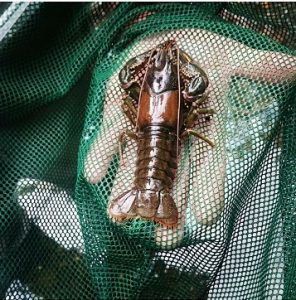Dams impact crayfish assemblages and genetic structure. - Cahaba River Society
By Zanethia Choice Barnett, PhD
Research Fisheries Biologist
CBHR Dive Safety Officer
Forest Service
Center for Bottomland Hardwoods Research
Southern Research Station

Alabama has the most diverse crayfish fauna in the world, with more than 90 native species found in the state. Crayfishes play an important role in stream ecosystems by breaking down plant materials, digging burrows that are sometimes used by other stream animals, and serving as predators of or prey for numerous animals, especially some game fishes such as bass and catfish. However, crayfish populations are declining worldwide, with 48% of North American crayfish species imperiled. Despite the importance of crayfishes, no previous study has examined the impacts of large dams on crayfishes. Dams and their impoundments change stream habitats and block movements of stream organisms, which subsequently changes the species present within the stream and isolates stream populations. The Lake Purdy dam was built on Little Cahaba River in 1911 to supply water to the Birmingham area. While this dam is essential to the people living in Birmingham, we must understand how it is impacting stream animals so that we are able to use this valuable resource without losing the amazing stream diversity within the Cahaba River drainage.
USDA Forest Service and University of Mississippi researchers, led by Dr. Zanethia Barnett, compared Little Cahaba River (Lake Purdy dam) and Shades Creek (no dam) crayfish diversity, density, and migration. Scientists collected seven crayfish species from Little Cahaba River and five species from Shades Creek. One invasive species, the virile crayfish (Faxonius virilis) was collected and was dominant throughout both streams. Crayfish density was lower downstream of Lake Purdy (Little Cahaba River) than upstream of Lake Purdy and at downstream sites in Shades Creek. No crayfishes were collected right below Lake Purdy dam, but crayfish density and richness (number of species) increased with distance away from the dam, showing that the crayfish assemblage recovered with distance from the dam. Crayfish assemblage differences between Little Cahaba River and Shades Creek were associated with more stable temperature and flow regimes, decreases in crayfish refuge habitats (e.g., aquatic vegetation), and increased abundances of predatory fishes (e.g., basses) in Little Cahaba River streams. Managing streams to mimic natural flow regimes may help maintain diverse stream communities. Lake Purdy dam also prevented crayfish upstream of the dam from moving to stream sections downstream and vice versa, reducing gene flow (movement and mating of crayfishes) between up- and downstream populations. No gene flow occurred between crayfishes up- and downstream of Lake Purdy, which isolates crayfish populations and increases their risk of local extinction. Conservation strategies focused on connecting crayfish populations up- and downstream of Lake Purdy– such as building fish ladders or moving crayfishes from downstream of the dam upstream — may help prevent the reduction and loss of crayfish populations. There is still much to learn about impoundment effects on crayfishes, but it is clear that changes to stream ecosystems by impoundments have major consequences for crayfishes.
We would like to thank Birmingham Water Works and the many landowners for allowing us to access the streams through their property. This study could not have been conducted without them!
Sources:
https://www.srs.fs.usda.gov//pubs/59267
https://egrove.olemiss.edu/cgi/viewcontent.cgi?article=2547&context=etd
Other articles about research:
https://www.srs.fs.usda.gov/compass/2020/08/04/dams-crayfish-genetics/
